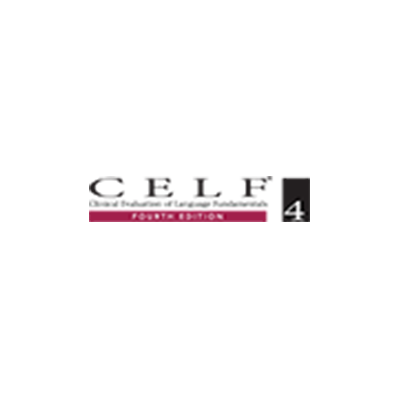Eleanor Semel, EdD, Elisabeth H. Wiig, PhD, Wayne A. Secord, PhD
Overview:Quickly and accurately identify and diagnose language disorders
Age Range:5 through 21 years
Scoring Option:Scoring Assistant or Manual Scoring
RTI Tiers:RTI Levels 2 and 3
Completion Time:30-60 minutes
Norms:Core Language Score, Receptive Language Score, Expressive Language Scores, Language Structure, Language Content, Language Memory, Working Memory Indexes as Standard Scores, Percentile Ranks, Age Equivalents
Publication Date:2003
Read about the new CELF-5.
 Break New Ground With CELF-4 and Set a New, More Comprehensive Standard for Excellence in Language Assessment
Break New Ground With CELF-4 and Set a New, More Comprehensive Standard for Excellence in Language Assessment
CELF-4 gives you everything that you are looking for when evaluating a student’s language performance. Combine core subtests with supplementary subtests
to get a comprehensive assessment of a student’s language skills.
CELF is based on a four-level process model.
Features & Benefits
- CELF-4 provides the bridge that helps you understand a child’s need for classroom language modifications, enhancements, or curriculum modifications
- Flexibility of subtest administration allows for shorter testing time while providing highly reliable, accurate results
- Composite scores include Core Language, Receptive Language, Expressive Language, Language Structure, Language Content, Language Memory, and Working Memory Indexes as Standard Scores
- Culturally appropriate contexts and visual stimuli make CELF-4 appropriate and interesting for all students
- Updated norms are based on a diverse standardization sample of 2,650 subjects that reflect the updated 2000 U.S. Census, including children with identified conditions and diagnosed language disorders.
- New subtests include Expressive Vocabulary, Word Definitions, Number Repetition 1 and 2, Phonological Awareness, Pragmatics Profile, and the Observational Rating Scale.
- CELF®–4 Interactive Training CD
Obtain descriptive indicators of students’ language performance in class and at home.
What’s New
Clinical Evaluation of Language Fundamentals-Fourth Edition (CELF-4)
The New CELF®–4
Moving Assessment to the Next Level
It’s faster, flexible, and more reliable.
The CELF®–4 Assessment Process model ultimately gives you everything you need when evaluating a student’s language performance to meet IDEA mandates.
- Faster administration of norm-referenced core subtests that gives an even more accurate diagnosis of a language disorder.
- Flexibility that lets you guide the assessment of your client to respond to referral questions, assessment needs, and program planning.
- More reliable with updated norms that reflect the 2000 U.S. Census, with 39% of the 2,650 students from minority families and 10% students identified as having a disability.
- Features new subtests including Expressive Vocabulary, Word Definitions, Number Repetition 1 & 2, Familiar Sequences 1& 2, Phonological Awareness, Pragmatics Profile, and Observational Rating Scale.
Accurately and Reliably
Determine a Child’s Language Disorder.
The CELF®–4 assessment process has the flexibility and diagnostic information that you need to design an individualized assessment path for each client.
Level 1 – The four most discriminating subtests enable you to quickly determine whether or not there is a language disorder in one-third less time.
Level 2 – Determine the nature of the disorder and the student’s strengths and weaknesses with two additional subtests to obtain Receptive Language, Expressive Language, Language Structure, Language Content, Language Memory, and Working Memory Index scores.
Level 3 – Decide what clinical skill deficits underlie the disorder with subtests such as Phonological Awareness, Rapid Automatic Naming, Number Repetition, Familiar Sequences, Word Associations, and Working Memory composite.
Level 4 – Explore how the student’s classroom language performance and social interactions are affected. Use the Pragmatics Profile and the Observational Rating Scale to continue your assessment.
Areas of Assessment
CELF-4 Subtest Chart

CELF-4 Scoring Assistant
Score CELF-4 accurately and quickly with new software that calculates the Core Language Score, norm-referenced indexes, criterion-referenced cut scores, and summarizes the authentic assessments.
The Scoring Assistant provides a Summary, a Composite Score Chart, a Scaled Scores Chart, a Narrative, an Item Analysis, a Pragmatics Profile, and an Observational Ratings Scales Report.
CELF®-4 Scoring and Report Assistant
Score CELF®-4 accurately and quickly with new software
- The CELF-4 Scoring and Report Assistant provides interpretive reports and customizable clinical tools to streamline the assessment process and help develop effective IEPs.
- Create the following reports with the click of a mouse: Parent, Interpretive, Summary, and Graphical. You can also create a customized list of therapy activities, classroom interventions, and recommendations, as well as a detailed history for each student.
Sample Reports
- CELF-4 Scoring Assistant Sample Report (PDF -91kb)
Alternative Item Analysis
Alternative Item Analysis for Word Classes 1 and 2
Performance in the below-average range on the Word Classes subtest indicates that the student does not associate related words automatically or efficiently. Adequate ability to perceive relationships in the meaning of words and form word associations is essential for classroom listening and reading comprehension. Deficits in recognizing and using word associations influence a student’s ability to make predictions, create meaning, make inferences, and use analogical reasoning for problem solving.
Examining subtest errors and categorizing them according to type will assist in extension testing, as well as in development of intervention strategies. Use of multiple categorizations can be helpful in examining a student’s nonverbal classification strategy. For example, when assessing a student who can identify that words are opposites but cannot explain the difference in the pair further, a therapist may need to examine the conceptual breakdown of the items (e.g., permanent and temporary are antonyms; both refer to temporal states).
The CELF–4 Examiner’s Manual provides Item Analyses for Word Classes 1 and 2, as well as a discussion of the function of Item Analyses, on pages 58–65. Alternative Item Analyses for the CELF–4 Word Classes items are provided below.
Alternative Item Analysis:
Reference Materials
CELF-4 Case Studies (PDF – 1544 KB)
Technical Reports
Correlations Between the CELF–4 and WISC–4 Integrated (PDF – 39kb)
CELF-4 Technical Report (PDF – 339kb)
-
CELF-4 Training CD
Provides in-depth training on each level of the CELF-4 assessment process. CELF-4 Training CD provides a comprehensive review of the Examiner’s Manual, record forms, stimulus books, and new subtests. Includes:
- Interactive presentation
- Case studies
- Training handouts
- Frequently asked questions
- Scoring Assistant software demonstration
- Additional printable resources

Pre-recorded Webinars
-
Answering Tough Questions in CELF-4 Diagnosis and Interpretation.
Presenter: Elisabeth H. Wiig, PhD

CELF-4 uses a comprehensive multi-level process model for evaluating language disorders in school-age children. This seminar provides clinicians the opportunity to ask the tough questions that arise when interpreting test results. Clinicians are encouraged to submit questions about specific cases or about subtests or scores before the session.
Date: Mar 05, 2010
Questions
Frequently asked questions follow. Click on a question to see the response.
Test Content
- What’s new with CELF–4?
- Does CELF–4 have any new subtests?
- Have any CELF subtests changed?
- Is the CELF–4 standardization sample representative of my population?
- Why does the Record Form for 9–21 years have items that are given to younger children?
Administration
- Can I test kindergarten students with CELF–4?
- Can CELF–4 be administered to children diagnosed with Intellectual Disability or Autism?
- Can I give CELF–4 to students who speak Spanish and English?
- Do I have to administer all of the subtests for a particular age?
- In Word Classes 1 and 2, if the student gets part 1 wrong, do I need to give part 2?
- Why would I want to administer the working memory subtests, i.e., Number Repetition and Familiar Sequences?
- When and why would I want to administer the Observational Rating Scales (ORS)?
- I tested at the beginning of the year, when can I test again?
Scoring
- My student earned no points on Semantic Relationships; can I still get a composite score that uses this subtest?







